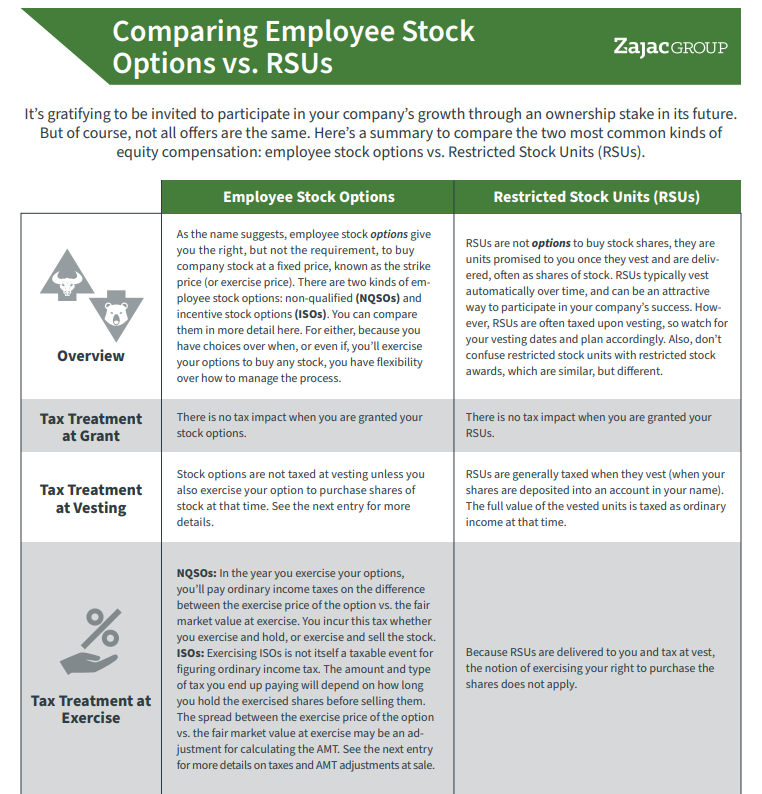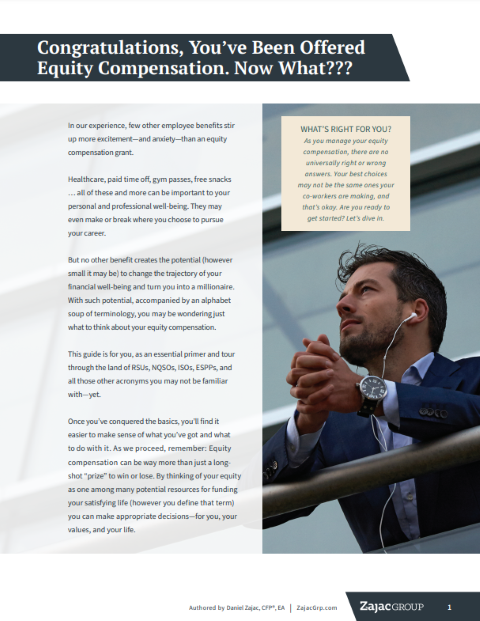If you have employee stock options, you’ve likely spent time considering how and when to turn the value of those options into cash proceeds you can actually use.
To turn stock employee stock options into cash, you have to exercise and sell them. When you exercise, you are buying shares of company stock at the exercise price of the employee stock option.
Buying shares of stock means that you still need to pay for them when you exercise — but you’re getting a bargain because the price you pay will likely be lower than the current market price of the stock itself.
The exact cost to exercise equals the number of shares you exercise multiplied by the exercise price of the stock option.
Understanding the Potential Costs of Exercising
Let’s assume you have the following:
| Grant | Shares | Exercise Price | FMV | Exercise Cost | Value |
| 1 | 10,000 | 5.00 | 25.00 | $50,000 | $200,000 |
In this example, the exercise cost of 10,000 shares is $50,000.
COMPARISON GUIDE
Not All Stock Offers are the Same! Here's a helpful comparison between two of the most common employee stock options.
However, you don’t have to exercise all your options at one time. If you only exercise 5,000 options (leaving you with 5,000 that can be exercised later), the exercise cost is $25,000, or 5,000 multiplied by $5 per share.
The same logic carries forward when you have multiple grants of stock options. For example, assume that you have the two employee stock option grants:
| Grant | Shares | Exercise Price | FMV | Exercise Cost | Value |
| 1 | 10,000 | 5.00 | 25.00 | $50,000 | $200,000 |
| 2 | 5,000 | 8.00 | 25.00 | $40,000 | $85,000 |
The total exercise cost of both grants, or 15,000 shares, is $90,000. Again, you can choose to exercise a portion; you don’t have to exercise everything all at once. You can exercise only grant 1, for example, or only grant 2 — or some or all of each.
The kind of employee stock options you have may impact the cost of exercising, as well. This is because the exercise of an employee stock option is a taxable event.
In addition to the cost you pay to buy the shares, you may also need to pay tax. The type of tax you pay, when you pay it, and how much you pay will all depend on whether you have incentive stock options or non-qualified stock options.
Because of this it’s important to check your document and be sure of what kind of options you have before you take any actions with them. Checking in with a professional who can help you choose the right strategy might be a prudent move, as well.
Exercise Strategy 1 – Pay with Cash
A simple and clean way to pay the exercise cost is to pay with cash. With a cash exercise, you must deliver the cash required to pay the exercise cost when you exercise your options.
Doing a cash exercise may be a good strategy if you’re bullish on the future stock price of your company stock and if you want to maximize the number of shares you own.
If we assume that you exercise Grant 1 above, you will pay $50,000 to exercise the employee stock option. This $50,000 needs to come from assets you own already (like cash in a bank account).
Post-exercise, you will own 10,000 shares outright — but you’ll have less money in the bank since you needed to use some cash on hand to buy the shares.
A cash exercise is effectively the opposite of diversification. This can be a good thing or a bad thing based on your goals, risk tolerance, and how the stock performs in the future.
Exercise Strategy 2 – Buy Using Shares Acquired via the Exercise Itself
A second strategy to exercise your employee stock options is cashless exercise (or a sell-to-cover). With a cashless exercise, you use newly acquired shares via the exercise itself to cover the exercise cost.
This is accomplished by giving instructions that requests the immediate exercise and sell enough shares to cover the cost of the exercise. You can retain whatever shares you didn’t need to sell to cover the cost of exercising.
If we looked at Grant 1 above, we can see the exercise cost is $50,000. In order to cover this exercise cost via cashless exercise, we need to calculate how many of the 10,000 shares must be sold immediately post-exercise to pay for the exercise cost of the employee stock option.
The math to calculate the shares required is as follows:
“Cashless Shares Required” = “Exercise Cost” / “FMV at Exercise”
= $50,000 / $25
= 2,000
If you immediately exercise and sell 2,000 of your 10,000 shares, exercised at the current share price of $25/share, you will generate $50,000 of proceeds. You can use this $50,000 to cover the exercise cost.
That means you are left with 8,000 exercised shares that you hold outright. The post-exercise result of a cashless exercise is that you will own fewer shares than you would with a cash exercise — but it also saves you from having to shell out $50,000 in cash.
A cashless exercise may be good for someone seeking to limit or diversify their company stock position. It may also be appropriate for someone who doesn’t have the requisite cash on hand to cover the exercise cost.
Exercise Strategy 3 – Use Previously Owned Shares of Stock via a Stock Swap
In addition to using cash or a cashless exercise to exercise your employee stock options, you can also use shares you already own to cover the exercise cost. You do this via a stock swap.
A stock swap allows you to exchange a sufficient number of shares you already own to cover the exercise cost of newly acquired shares from the stock option. You can use long-only shares, vested RSUs, exercised NQSOs, employee stock purchase plan shares, and exercised incentive stock options in stock swaps.
Each type of owned stock may have different rules that should be understood if being used for a swap, and you should consider the impact of each when before choosing a strategy to implement.
When you do a stock swap, the original holding period and tax cost basis will transition to the swapped shares in a non-taxable event. However, the exercise itself is a taxable event.
Let’s assume the following:
| Grant/Share | Shares | Exercise Price | FMV | Exercise Cost | Value |
| Long-Only | 10,000 | – | 25.00 | – | $250,000 |
| NQSO | 5,000 | 8.00 | 25.00 | $40,000 | $85,000 |
If the goal is to exercise 5,000 NQSOs, the cost to exercise will be $40,000. In lieu of paying cash or doing a cashless exercise, you can use some of your long-only shares to cover the cost.
To cover the $40,000 exercise cost, you will need to swap 1,600 long-only shares (1,600 x $25 per share equals $40,000).
Post-exercise, you will retain 8,400 long-only shares and 5,000 NQSO shares, now owned outright. That gives you a total of 13,400 shares.
Like a cashless exercise, a stock swap means that you will typically own fewer shares post-exercise than you will with a cash exercise. A stock swap may be a good option for someone who is seeking to limit exposure to company stock.
Exercise Strategy 4 – Use a Combination of Strategies 1, 2, and 3
For any number of reasons, a singular strategy to implement only options 1, 2, or 3 may not be appropriate. The best exercise strategy for you might actually be a combination of strategies 1, 2, and 3 above.
This might be true even if you used one strategy over another in the past. Every time you exercise gives you an opportunity to implement a different strategy.
For example, you may choose to exercise lot 1 in our example via a cash exercise. A year later when you go to exercise lot 2, you may choose a stock swap.
Regardless of what you decide to do, you need to be aware of the tax implications of any exercise. Those implications alone can generate a separate, additional cash call when you exercise or when you file your tax return.
The Bottom Line on Exercising Your Employee Stock Options
If you are seeking to exercise your employee stock options, it means they are in the money and you capture real value. That the good news. To capture that value, however, you need to pay the exercise cost.
You can do that in a number of ways, using any (or a combination of) the strategies outlined above. Bear in mind, however, that any kind of exercise can lead to other complications.
Personal financial planning goals, your available assets, your short- and long-term opinions of the company stock, and the pending income tax implications may make exercising your ESO a daunting responsibility.
If you find yourself with unanswered questions about how to pay for your exercise, when to exercise, and how this all fits together, you may want to reach out to a professional who can help.










What happens to the average share cost if I have stock of a company ABC and exercise a call option on the same ABC stock? Does the average cost get calculated using call strike price strike price + premium?